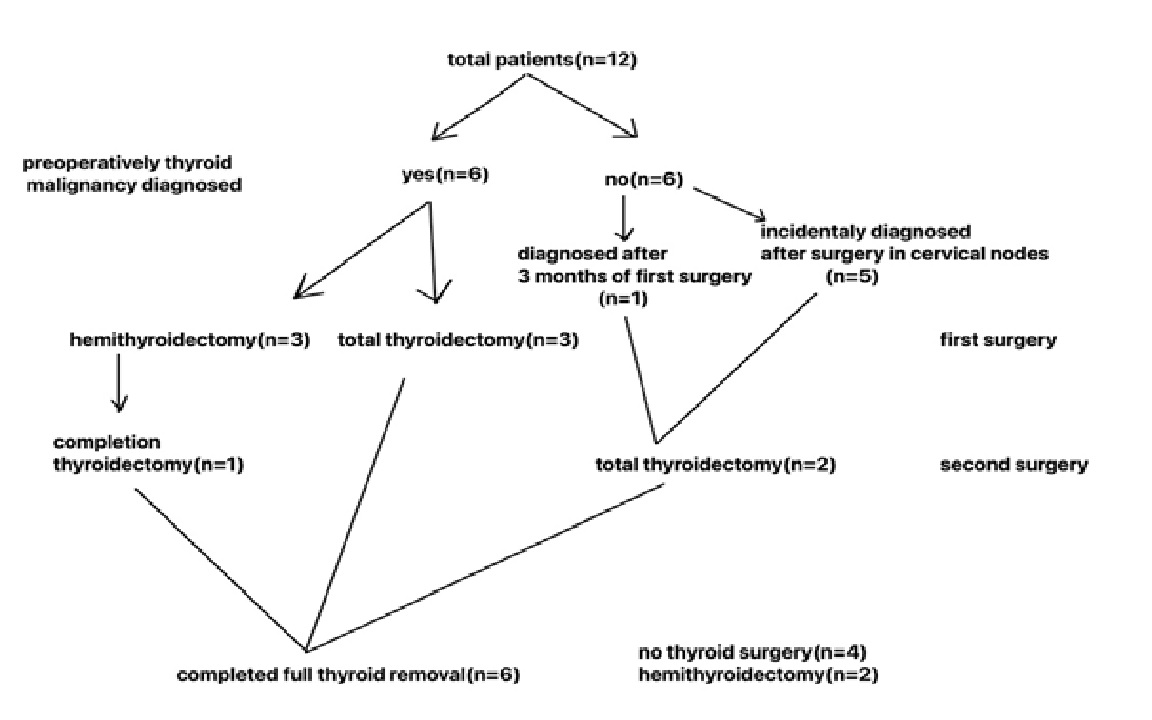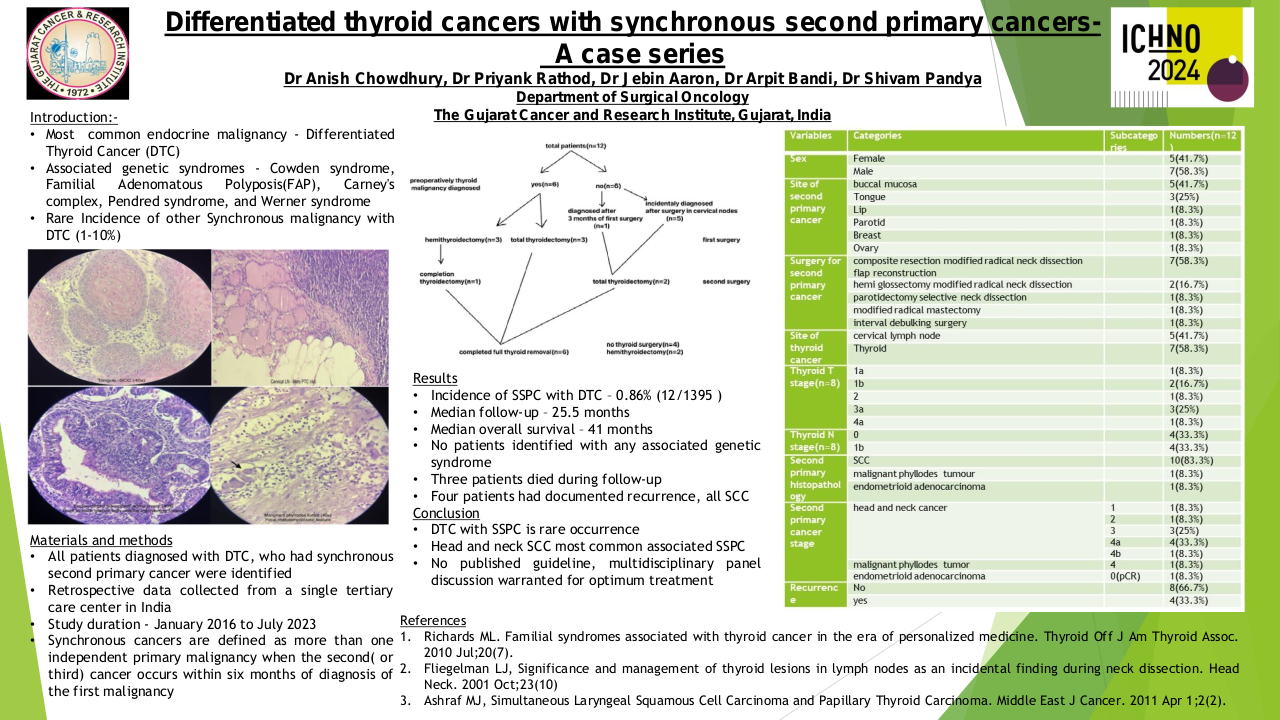Differentiated Thyroid Cancer with Synchronous second Primary Cancer : Retrospective study from a cancer institute in India
Purpose/Objective
Thyroid cancer is the most common endocrine malignancy, accounting for 1 % of all cancers 1. The genetic syndromes associated with differentiated thyroid cancers(DTC) are Cowden syndrome, Familial Adenomatous Polyposis(FAP), Carney's complex, Pendred syndrome and Werner syndrome2. The incidence of synchronous second primary tumors(SSPC) associated with oropharyngeal malignancies was 1 to 10 %3. The incidence of other malignancies other than the above syndromes occurring synchronously with DTC is very rare. Only a few case reports and series are available. The incidence of synchronous second primary cancer(SSPC) with Differentiated Thyroid Cancers(DTC) is a very rare entity. Very few case reports and case series were published in the literature. The current study is aimed to enumerate the clinicopathological data of patients with DTC with SSPC.
Material/Methods
This is a single-center retrospective study. All the patients diagnosed with DTC and SSPC from January 2016 to July 2023 were included in the study. The demographic, clinicopathological data and survival data were collected from the institute's database. Patients were followed up telephonically and survival status was documented. Synchronous cancers are defined as more than one independent primary malignancy when the second( or third) cancer occurs within six months of diagnosis of the first malignancy4.
Results
A total of 1395 patients were diagnosed with thyroid cancer during the study period. Twelve patients were found to have DTC with SSPC. All the patients had papillary thyroid cancer as primary DTC. Ten patients had head and neck squamous cell carcinoma, one had malignant phyllodes tumor, and another patient with endometrioid adenocarcinoma as the SSPC. Six patients diagnosed during preoperative evaluation, one patient diagnosed 3 months after the oral malignancy diagnosis and five patients were diagnosed to have PTC in cervical nodes after neck dissection. Complete thyroid removal was done in six patients and hemithyroidectomy in two patients. Among the patients who underwent total thyroidectomy, four patients had undergone radioactive iodine scan followed by radioactive iodine ablation for two patients. Three patients had died during follow-up, two patients was lost to follow-up and the rest of the seven patients were alive. Out of those alive one patient had a follow-up of less than six months and was excluded from the survival calculation. The median follow up was 25.55 months. The median overall survival was 40.97 months.
Conclusion
DTC constitute 95% of thyroid malignancies. Five to fifteen percent of DTC has familial disease. The genetic syndromes associated with DTC are FAP, PTEN syndromes(Cowden syndrome, Bannayan- Riley- Ruvalcaba syndrome, PTEN hamartoma tumor syndrome), Werner syndrome, Carney complex, DICER1 syndrome, Pendred syndrome, Ataxia telangiectasia, Li Fraumeni syndrome, and Peutz Jeghers syndrome5. But, synchronous occurrence of a second malignancy with DTC is a rare phenomenon.
In the present study, the most common SSPC was SCC of the head and neck region(83.3%). 5 patients had incidental detection of thyroid cancer in cervical lymph nodes which were dissected during neck dissection done for other causes. L J Fliegelman et al published a paper on four cases of incidentally detected thyroid malignancy in cervical nodes6. Ansari-Lari et al also published cases of incidentally diagnosed PTC on cervical lymph nodes7.
In the present study, one patient had synchronous papillary thyroid carcinoma with a malignant phyllodes tumor of the breast. No such case was found reported in the literature during our literature search.
In the present study, we reported a case of synchronous endometrioid adenocarcinoma with PTC. Badan Marius-loan et al reported one case of PTC with endometrioid carcinoma8. Patients with Cowden syndrome can have thyroid carcinoma and endometrial carcinoma9.
The overall survival of the study group was 40.97 months. Biopsy-proven SCC recurrence was seen in two patients out of four patients with clinically documented recurrence. In the literature review on case series and case reports, it was concluded that the prognosis of the patient depends on the staging of oral synchronous primary and the treatment of thyroid cancer must be decided based on oral malignancy staging and treatment.
In conclusion SSPC with DTC is a very rare phenomenon. SCC of the head and neck region is the most common synchronous second primary malignancy associated with DTC. As there are no published guidelines for this clinical scenario, a multi-disciplinary panel discussion is a must to decide regarding management considering the staging and weighing the treatment benefit for both malignancies.
1. Balajam NZ, Mousavian AH, Sheidaei A, Gohari K, Tavangar SM, Ghanbari-Motlagh A, et al. The 15-year national trends of endocrine cancers incidence among Iranian men and women; 2005–2020. Sci Rep. 2023 May 10;13(1):7632.2. Richards ML. Familial syndromes associated with thyroid cancer in the era of personalized medicine. Thyroid Off J Am Thyroid Assoc. 2010 Jul;20(7):707–13.3. Xu CC, Biron VL, Puttagunta L, Seikaly H. HPV Status and second primary tumours in Oropharyngeal Squamous Cell Carcinoma. J Otolaryngol - Head Neck Surg. 2013 May 29;42(1):36.4. De Luca A, Frusone F, Vergine M, Cocchiara R, La Torre G, Ballesio L, et al. Breast Cancer and Multiple Primary Malignant Tumors: Case Report and Review of the Literature. Vivo Athens Greece. 2019;33(4):1313–24.5. Kamani T, Charkhchi P, Zahedi A, Akbari MR. Genetic susceptibility to hereditary non-medullary thyroid cancer. Hered Cancer Clin Pract. 2022 Mar 7;20:9.6. Fliegelman LJ, Genden EM, Brandwein M, Mechanick J, Urken ML. Significance and management of thyroid lesions in lymph nodes as an incidental finding during neck dissection. Head Neck. 2001 Oct;23(10):885–91.7. Ansari-Lari MA, Westra WH. The prevalence and significance of clinically unsuspected neoplasms in cervical lymph nodes. Head Neck. 2003;25(10):841–7.8. Marius-Ioan B, Doina P. Triple Metachronous Malignancies with Thyroid Involvement: A Brief Overview of Five Case Reports over 20 Years of Institutional Experience. Diagnostics. 2020 Mar 20;10(3):168.9. Porto ACS, Roider E, Ruzicka T. Cowden Syndrome: report of a case and brief review of literature. An Bras Dermatol. 2013;88(6 Suppl 1):52–5.






